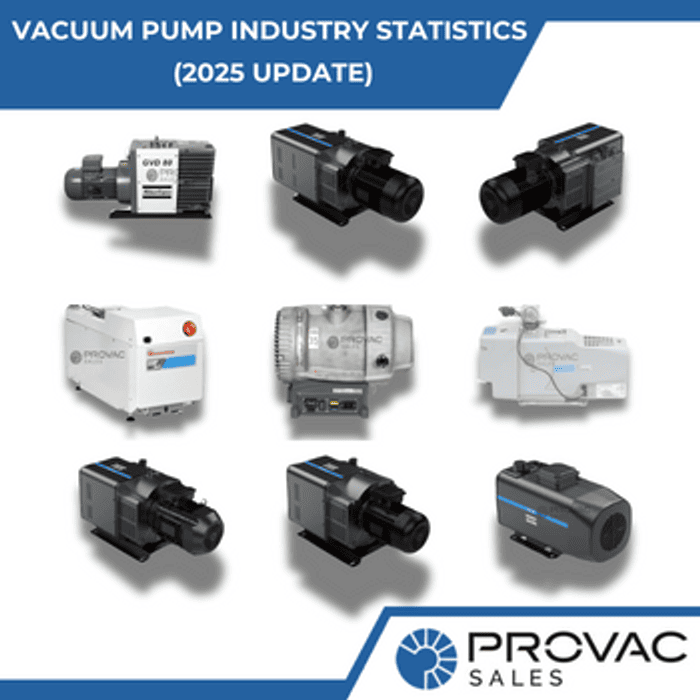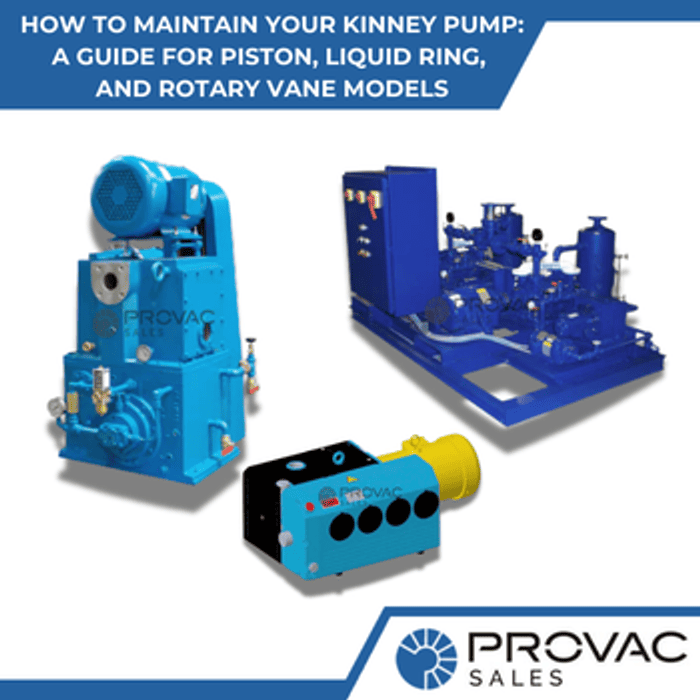When it comes to choosing the right pump for your operation, it's a bit like choosing between a truck and a sports car. They both get you from point A to point B, but how they do it (and what they’re best at) couldn’t be more different.
At Provac, we know how important that decision is, especially when it involves critical systems that can make or break your process flow. If you’re torn between a Kinney rotary vane vacuum pump and a dry screw pump, you’re in the right place.
What Does a Vacuum Pump Really Do?
Before we get into the Kinney vs. dry screw pump debate, let’s take a quick detour. A vacuum pump isn’t just some mysterious machine humming in the background. It’s responsible for removing gas molecules from a sealed volume to create a partial vacuum.
Think semiconductor manufacturing, food packaging, medical sterilization, or chemical processing. Without the right vacuum pump, things just don’t work as they should, or worse, they break down completely.
That’s where the type of pump really matters. There’s no universal solution. It's all about matching the tool to the job.
The Kinney Rotary Vane: A Time-Tested Workhorse
Rotary vane pumps are like that dependable friend who always shows up on time, rain or shine. Kinney has spent decades perfecting this style, and it shows in the performance.
So, how does a rotary vane vacuum pump actually work? Picture a circular rotor spinning inside a cavity. Vanes (usually spring-loaded) slide in and out of the rotor slots, making contact with the pump’s walls to trap air, compress it, and push it out. It’s a smooth, simple, and effective process.
Here are some reasons to choose a Kinney rotary vane pump:
-
Durability: These pumps are built tough. You can run them around the clock and still count on them years later.
-
Efficiency: The design is streamlined for steady vacuum performance with minimal fuss.
-
Low Maintenance: While oil-sealed models need occasional fluid changes, they’re surprisingly easy to maintain.
-
Affordable Reliability: When budget matters but you still need rock-solid performance, Kinney rotary vane pumps hit the sweet spot.
There’s a reason rotary vane technology has stuck around so long. It’s not flashy, but it gets the job done exceptionally well.
Dry Screw Pumps: The Clean, High-Tech Alternative
Now, let’s talk about dry screw pumps. These machines operate using two interlocking screw rotors that rotate in opposite directions. As the screws turn, gas is trapped and moved along the threads, compressed, and discharged, without any oil or sealing fluid in the compression chamber. That “dry” design is a game changer in specific industries.
Here’s where dry screw pumps shine:
-
Contamination-Free Operation: No oil means no risk of backstreaming into your system. That’s huge in food, pharma, or semiconductor applications.
-
Easy Cleanup: If your process involves corrosive gases or particulates, a dry screw pump makes maintenance simpler. Some even have clean-in-place options.
-
High Throughput for Heavy-Duty Jobs: These pumps can handle aggressive vapors and harsh environments.
That said, dry screw vacuum pumps are not for every scenario. They often come with a higher upfront cost and may require more technical know-how for proper setup and control.
Comparing Kinney Rotary Vane and Dry Screw Pumps: A Feature-Focused Breakdown
When evaluating vacuum pump options for industrial applications, understanding the specific features of each type is essential.
Lubrication and Operation
Kinney rotary vane pumps operate with an oil-sealed system, meaning oil is used in the compression chamber to lubricate moving parts and create a tight seal. This helps ensure efficient operation and reliable vacuum performance.
In contrast, dry screw pumps run completely oil-free within the compression chamber. This “dry” mechanism eliminates the risk of oil contamination in sensitive processes and simplifies waste disposal.
Contamination Risk
Because Kinney rotary vane pumps use oil, there is a moderate risk of contamination, particularly if oil leaks or degrades over time. However, with consistent maintenance and oil changes, this risk is manageable.
Dry screw pumps, on the other hand, pose no risk of oil-based contamination, making them ideal for industries like pharmaceuticals and semiconductors where cleanliness is non-negotiable.
Cost Considerations
One of the key advantages of Kinney rotary vane pumps is their lower initial cost. They’re a budget-friendly solution for standard applications requiring reliable performance.
Dry screw pumps, though generally more expensive upfront, justify the investment in applications where maintenance downtime or contamination can be extremely costly.
Maintenance and Longevity
Kinney rotary vane pumps are known for simple and predictable maintenance, usually centered around scheduled oil changes and vane replacements. Their maintenance schedule is straightforward, even for smaller facilities.
Dry screw pumps require moderate maintenance, often depending on the materials being processed. In some cases, aggressive or corrosive gases may demand more frequent service or specialized coatings.
Operating Environment
The Kinney rotary vane pump excels in clean to moderately dirty environments, such as packaging, refrigeration, or general lab use. It performs well under standard industrial conditions.
In contrast, dry screw pumps thrive in harsh or reactive gas environments, such as chemical processing or vacuum distillation. Their dry design prevents cross-contamination and offers excellent durability in challenging settings.
Noise Level
In terms of sound, Kinney rotary vane pumps operate at a moderate noise level that’s acceptable for most industrial environments. Dry screw pumps, due to their design, are often quieter, making them suitable for noise-sensitive areas or operations that run continuously.
Typical Applications
Kinney rotary vane pumps are commonly used in packaging systems, HVAC and refrigeration, laboratory setups, and light industrial processes. Their dependability and ease of use make them a go-to solution for general vacuum needs.
Dry screw pumps are more specialized, excelling in pharmaceutical production, semiconductor manufacturing, and chemical processing, where cleanliness, corrosion resistance, and precise control are essential.
Choosing Based on Your Process Needs
Alright, let’s stop speaking in generalities and zoom in on your situation. Here are some real-world tips to steer you in the right direction:
-
If you need a dependable all-around vacuum pump for general applications like packaging, house vacuum, go with the Kinney rotary vane. It offers proven performance without burning a hole in your budget.
-
If your process involves moisture, chemicals, or highly reactive gases, a dry screw pump might be the better investment. You’ll avoid oil contamination and simplify cleaning.
-
If downtime is your mortal enemy, Kinney vane pumps are easier to maintain with fewer parts that go wrong. They’re practically built to be the unsung hero of 24/7 operations.
-
If your product or process can’t tolerate oil, or you’re in a cleanroom environment, dry screw wins, hands down.
Sometimes it’s not just about the pump itself, it’s about what happens when things go wrong. If serviceability matters (and it should), Kinney pumps have fewer moving parts and a long track record of field success. Provac has worked with hundreds of clients who come in looking for a fancy solution and leave with a Kinney rotary vane, and thank us for it six months later.
What About Energy Consumption?
Great question. Energy costs add up fast, especially in industrial setups. Rotary vane pumps tend to be more energy-efficient at lower pressures and continuous operation. They’re also easier to size correctly, so you’re not overpaying to run a pump that’s too big for the job.
Dry screw pumps, on the other hand, can consume more power depending on the load. But they make up for it in specific conditions, especially when you're dealing with tough vapors or need deep vacuum levels fast.
The right call? Look at your duty cycle, gas load, and maintenance schedule. If your vacuum pump runs 24/7 in a steady-state process, rotary vane efficiency can be a quiet moneymaker.
Don’t Forget About Noise and Footprint
You wouldn’t buy a jet engine to run a lemonade stand. Likewise, you don’t want a vacuum pump that overwhelms your workspace or shatters your peace. Rotary vane pumps tend to be compact and produce moderate noise. A well-installed Kinney unit hums along like a content cat, hardly noticeable once it’s running.
Dry screw pumps are generally quieter, especially at higher speeds or loads, which can be a real perk in sensitive work environments.
Also worth noting: vane pumps usually have a smaller footprint, which is great if you’re short on space.
Real-Life Scenarios: What Provac Recommends
Let’s say you're running a small food packaging line. You want dependable suction, minimal downtime, and compliance with food safety standards. A Kinney rotary vane vacuum pump is probably your best bet. It’s easy to clean, easy to service, and built to last.
Now let’s shift gears. You’re managing a chemical process plant handling aggressive solvents. You can’t risk contamination, and you need a pump that’s up to the challenge. This is where a dry screw pump really shines.
At Provac, we don’t just sell pumps, we help people solve problems. Our team takes the time to understand your process, your constraints, and your goals. That’s why we keep both options in stock and help guide you to the one that fits you, not the other way around.





